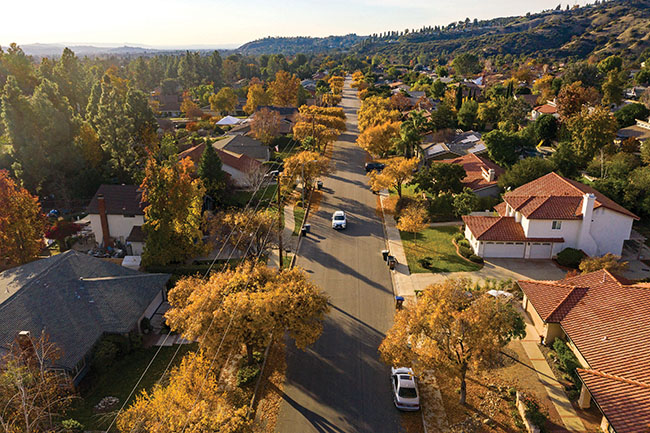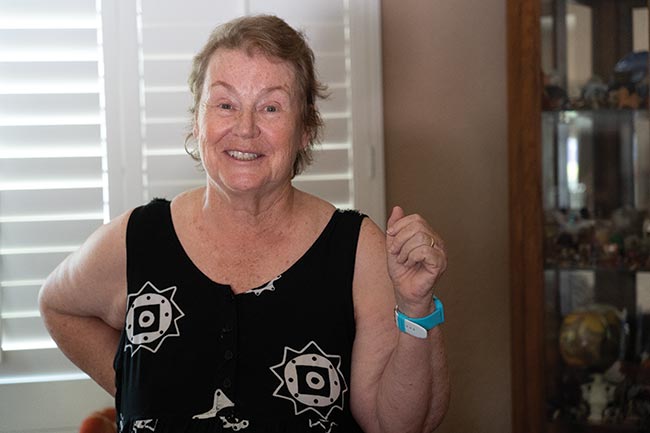Good and bad: residents react to recent changes in the City of Trees

A sampling of Claremont's highly regarded tree canopy. Courier photo/Peter Weinberger
by Andrew Alonzo | aalonzo@claremont-courier.com
It’s clear Claremont has changed quite a bit since its 1887 founding, what with paved roads, citrus groves planted and eventually removed for housing, and steady population growth. But what about the impact of its recent changes?
The Courier went to the source and asked residents how they’ve interpreted the city’s contemporary changes.
Larry Rinard, 69, is a 1973 Claremont High graduate. He’s lived here 48 years.
“The Village has changed 100 percent since when I was growing up,” Rinard said. “I mean there used to be gas stations in the Village, markets, hardware stores. Now it’s just all restaurants.”
Despite its relatively expensive housing, Rinard said his slice of Claremont has seen its share of new neighbors, with young families joining longtime residents.
Jean McDonald lives in a cul-de-sac east of Mills Avenue. She and her husband moved to Claremont 58 years ago to pursue teaching careers and have since grown fond of the city. She enjoys the little things that make it a safe community, such as not allowing overnight parking on city streets. And while the city’s population has increased over the nearly six decades she’s been here, McDonald said she still views Claremont as a small, senior-friendly community.
Elizabeth Smith, 70, is a 43-year resident. She and her husband were attracted to the City of Trees for its community feel and the proximity of her favored church.
“I was a Presbyterian, so we started looking for a church in the middle and found the Claremont Presbyterian Church,” she said.

Elizabeth Smith is a 43-year Claremont resident. Courier photo/Andrew Alonzo
Smith views the city as an “oasis” between San Bernardino and Los Angeles counties. Her children all attended Claremont Unified School District schools, and the family has enjoyed having many prestigious universities nearby. And though she’s grown to love the city, Smith said she’s less enamored of its current leadership.
“We used to have a City Council that knew the city inside and out,” Smith said. “Now, except for Corey [Calaycay], we seem to have a council that is afraid of Sacramento, that is willing to bend over backwards to change the city. I wish our City Council were a little stronger in standing up to Sacramento. Sacramento doesn’t live here. We live here. We want to protect it.”
With new housing being built and longtime staples like Candlelight Pavilion going out, Smith wonders about her new neighbors.
“I mean are they people who are going to stick around and add to the community and be a part of the community or are they people who work someplace else and live here?” she asked. “I worry about growing too large. I mean I’ve just seen them build almost everywhere.”
Smith’s 66-year-old neighbor, Susan Edwards, has been in Claremont since 1987, when she was lured by work at Claremont McKenna College, from where she retired in 2022 after 16 years. Her husband David Edwards continues to manage CMC’s Marian Miner Cook Athenaeum.
The Edwards family’s three children all attended CUSD schools as well. Susan Edwards was involved with the school district, city government, and various committees, including the Independence Day Committee and Human Services Commission. She recalled a time when citizen volunteers played a major role in city programs.
“I think it’s moved away a little bit from that,” she said. “The Fourth of July would be one example. We used to have very robust citizen volunteers for the Fourth of July that ran it and did everything. And, little by little, city staff decided that they needed to take over a lot of the stuff and now they have five volunteers and the city has to run the rest of it.”
She also shared how the once close relationship between the Claremont Colleges and city leaders seems to have cooled.
“It’s kind of funny because I both worked there and I’m a townie. I’m not one of these townies who thinks the Colleges owe us. But on the other hand, I think the Colleges take for granted the benefits that they get from being in a small community,” she said. “I don’t think that there’s as much collaboration between the Colleges and city officials as there were 35 years ago.”
Asked about positive changes Edwards named Village expansion, new businesses, and a police department that has added more female officers over the years. Claremont, she said, has influenced her and continues to shape her.
With roots in both the residential and business communities, Ray Lantz, 44, owner of The Diamond Center in the Village, offered a unique perspective.

Ray Lantz, owner of The Diamond Center, is a 12-year resident of Claremont. Courier photo/Andrew Alonzo
“I always liked Claremont,” the 12-year resident said. “I think that being a part of different communities of people in this area was always appealing to me because my grandparents were part of the community, my parents were part of the community, and now we are. And those connections with people and being around family is always what’s kind of been most important to me and to my family now.”
With the addition of the Claremont Farmers and Artisans Market in 1996, and ever-changing businesses, Lantz said the city has only gotten more vibrant.
“We don’t see a lot of chain businesses here like we might in other downtowns, and I think that’s what makes it special and that’s what gives it — and always has given it — a very different feel and flavor,” Lantz said.
Lantz embraces new business with open arms, and said in his line of work, “We do get a front row seat into people’s stories sometimes.” Lantz said he continues to “marvel at how many different types of cool people I come across.”
Lauren Stobel, 44, is the California Botanic Garden’s assistant director of visitor engagement, public relations and events. She grew up in Maryland but came to Claremont in 2010.
“I had no experience with Southern California at all basically before we moved here,” she said. “I think coming in we had the perception of the town as a sleepy suburb of Los Angeles because that’s sort of more what it was like when [her husband] lived here in the late ‘90s, early 2000s.”
Since the move, her affection for the city — and CalBG — has grown.
“There was a lot going on in town, a lot of arts, a lot of restaurants, and we chose to live as close to the Village as possible,” Stobel said. “It’s been nice to have the small town vibe. We’re super happy that we ended up here and have been able to put down roots here.”
The Foothill Boulevard Master Plan Improvements Project is a difference Stobel has appreciated.
“It really changes the experience of traveling around town to have the streets be so beautiful and so much color and habitat for animals and everything like that,” she said. “I would love to see even more of that in the surrounding areas and all through town.”
Rinard summed up his view of the changes he’s seen over nearly five decades in the City of Trees:
“It’s a good place. There doesn’t seem to be a whole lot of crime. It could be very boring, but maybe that’s good, I don’t know,” he said with a laugh. “I look back and see all the changes and everything, but … as you live here every day, you notice a lot of changes, but whether it’s good or bad, I don’t know.
“I mean I kind of miss all the lemon groves, you know?”










0 Comments